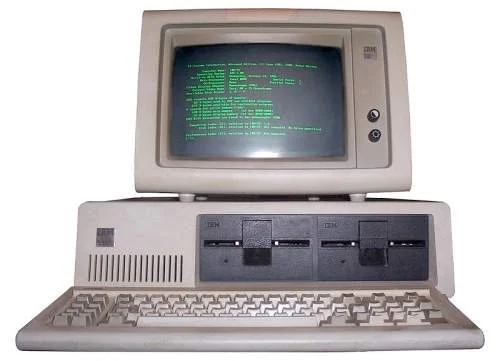August 1981: Ronald Reagan was U.S. president, MTV launched on cable TV and Libyan leader Muammar al-Gaddafi sent Sukhoi Su-22 fighter jets to intercept American fighters over the Gulf of Sidra.
Of course, August 1981 was also the month IBM kicked off the the modern PC revolution with the debut of its 5150.

The $1,565 starting price tag bought a system unit, keyboard and color/graphics capability. Additional options included a display, printer, two diskette drives, extra memory, communications, game adapter and application packages – including one for text processing.
The system unit – powered by an Intel 8088 microprocessor – was the size of a portable typewriter and contained 40K of read-only memory, 16K of user memory, as well as a built-in speaker for generating music. Its five expansion slots could be used to connect such features as expanded memory, display/printing units and game “paddles.”
Containing 83 keys, the keyboard was connected to the unit by a six-foot coiled cable, which meant users could rest it in their lap or on the desktop without moving the rest of the system. It also featured such advanced functions as a numeric keypad and 10 special keys – enabling users to write or edit text, figure accounts and store data.
That was August 12, 1981, exactly 30 years ago today.
Although Big Blue may have started the PC revolution way back when, Mark Dean, IBM’s CTO for the Middle East and Africa, says he is proud the corporation embraced the post-PC era in 2005 by selling its personal computer business to Lenovo.
“My primary computer now is a tablet. When I helped design the PC, I didn’t think I’d live long enough to witness its decline,” Dean wrote in a blog post titled “IBM leads the way in the post-PC era,” published on A Smarter Planet.
“But, while PCs will continue to be much-used devices, they’re no longer at the leading edge of computing. They’re going the way of the vacuum tube, typewriter, vinyl records, CRT and incandescent light bulbs.”
Dean also noted PCs were being replaced by “new ideas” about the role computing can play in terms of progress.
“These days, it’s becoming clear that innovation flourishes best not on devices but in the social spaces between them, where people and ideas meet and interact… It is there that computing can have the most powerful impact on economy, society and people’s lives.”
Unsurprisingly, Microsoft rep Frank X. Shaw responded quite differently to the anniversary of IBM’s 5150, saying he prefers to think of 2011 and beyond as the “PC-plus” era.
“We have a unique point of view when it comes to this future of devices and services. As we look ahead to the next 30 years, we’ll continue to lead the industry forward in bringing technology to the next billion (or 2 billion or 6 billion) people on our planet.
“[These] experiences [will] combine increasingly powerful and specialized devices with cloud services that’ll make it breathtakingly simple to create, organize, share, find, analyze and archive information, from documents and presentations, to photos, videos [and] podcasts.”
Post-PC or PC-plus, it’s been a hell of a ride thus far. We at TG Daily look forward to the next 30 years of technology and geeky goodness.






